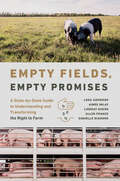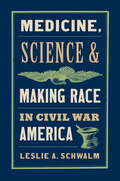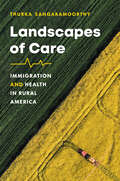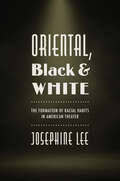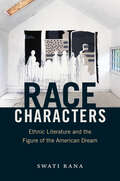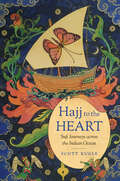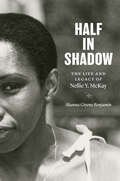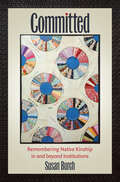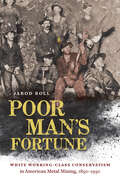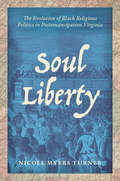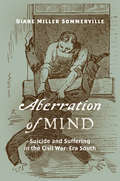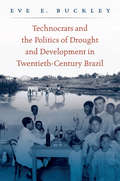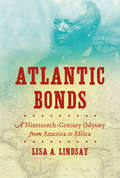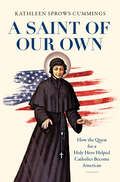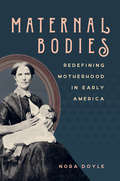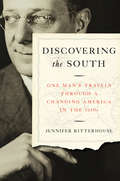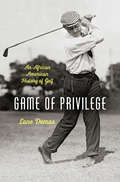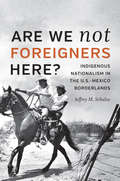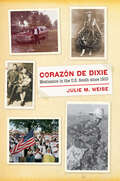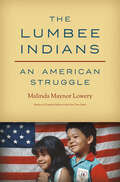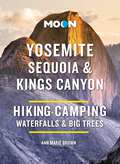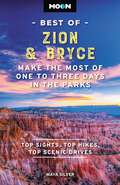- Table View
- List View
Empty Fields, Empty Promises: A State-by-State Guide to Understanding and Transforming the Right to Farm (Rural Studies Series)
by Loka Ashwood Danielle Diamond Allen Franco Aimee Imlay Lindsay KuehnThe right to farm is essential to everyone's survival. Since the late 1970s, states across the nation have adopted so-called right-to-farm laws to limit nuisance suits loosely related to agriculture. But since their adoption, there has yet to be a comprehensive analysis of what these laws do and who they benefit. This book offers the first national analysis and guide to these laws. It reveals that they generally benefit the largest operators, like processing plants, while traditional farmers benefit the least. Disfavored most of all are those seeking to defend their homes and environment against multinational corporations that use right-to-farm laws to strip neighboring owners of their property rights. Through what the book calls the "midburden," right-to-farm laws dispossess the many in favor of the few, paving the path to rural poverty. Empty Fields, Empty Promises summarizes every state's right-to-farm laws to help readers track and navigate their local and regional legal landscape. The book concludes by offering paths forward for a more distributed and democratic agrifood system that achieves agricultural, rural, and environmental justice.
Medicine, Science, and Making Race in Civil War America
by Leslie A. SchwalmThis social and cultural history of Civil War medicine and science sheds important light on the question of why and how anti-Black racism survived the destruction of slavery. During the war, white Northerners promoted ideas about Black inferiority under the guise of medical and scientific authority. In particular, the Sanitary Commission and Army medical personnel conducted wartime research aimed at proving Black medical and biological inferiority. They not only subjected Black soldiers and refugees from slavery to substandard health care but also scrutinized them as objects of study. This mistreatment of Black soldiers and civilians extended after life to include dissection, dismemberment, and disposal of the Black war dead in unmarked or mass graves and medical waste pits. Simultaneously, white medical and scientific investigators enhanced their professional standing by establishing their authority on the science of racial difference and hierarchy. Drawing on archives of the U.S. Sanitary Commission, recollections of Civil War soldiers and medical workers, and testimonies from Black Americans, Leslie A. Schwalm exposes the racist ideas and practices that shaped wartime medicine and science. Painstakingly researched and accessibly written, this book helps readers understand the persistence of anti-Black racism and health disparities during and after the war.
Landscapes of Care: Immigration and Health in Rural America (Studies in Social Medicine)
by Thurka SangaramoorthyThis insightful work on rural health in the United States examines the ways immigrants, mainly from Latin America and the Caribbean, navigate the health care system in the United States. Since 1990, immigration to the United States has risen sharply, and rural areas have seen the highest increases. Thurka Sangaramoorthy reveals that that the corporatization of health care delivery and immigration policies are deeply connected in rural America. Drawing from fieldwork that centers on Maryland's sparsely populated Eastern Shore, Sangaramoorthy shows how longstanding issues of precarity among rural health systems along with the exclusionary logics of immigration have mutually fashioned a "landscape of care" in which shared conditions of physical suffering and emotional anxiety among immigrants and rural residents generate powerful forms of regional vitality and social inclusion. Sangaramoorthy connects the Eastern Shore and its immigrant populations to many other places around the world that are struggling with the challenges of global migration, rural precarity, and health governance. Her extensive ethnographic and policy research shows the personal stories behind health inequity data and helps to give readers a human entry point into the enormous challenges of immigration and rural health.
Oriental, Black, and White: The Formation of Racial Habits in American Theater
by Josephine LeeIn this book, Josephine Lee looks at the intertwined racial representations of nineteenth- and early twentieth-century American theater. In minstrelsy, melodrama, vaudeville, and musicals, both white and African American performers enacted blackface characterizations alongside oriental stereotypes of opulence and deception, comic servitude, and exotic sexuality. Lee shows how blackface types were often associated with working-class masculinity and the development of a nativist white racial identity for European immigrants, while the oriental marked what was culturally coded as foreign, feminized, and ornamental. These conflicting racial connotations were often intermingled in actual stage performance, as stage productions contrasted nostalgic characterizations of plantation slavery with the figures of the despotic sultan, the seductive dancing girl, and the comic Chinese laundryman. African American performers also performed common oriental themes and characterizations, repurposing them for their own commentary on Black racial progress and aspiration. The juxtaposition of orientalism and black figuration became standard fare for American theatergoers at a historical moment in which the color line was rigidly policed. These interlocking cross-racial impersonations offer fascinating insights into habits of racial representation both inside and outside the theater.
Race Characters: Ethnic Literature and the Figure of the American Dream
by Swati RanaA vexed figure inhabits U.S. literature and culture: the visibly racialized immigrant who disavows minority identity and embraces the American dream. Such figures are potent and controversial, for they promise to expiate racial violence and perpetuate an exceptionalist ideal of America. Swati Rana grapples with these figures, building on studies of literary character and racial form. Rana offers a new way to view characterization through racialization that creates a fuller social reading of race. Situated in a nascent period of ethnic identification from 1900 to 1960, this book focuses on immigrant writers who do not fit neatly into a resistance-based model of ethnic literature. Writings by Paule Marshall, Ameen Rihani, Dalip Singh Saund, Jose Garcia Villa, and Jose Antonio Villarreal symbolize different aspects of the American dream, from individualism to imperialism, assimilation to upward mobility. The dynamics of characterization are also those of contestation, Rana argues. Analyzing the interrelation of persona and personhood, Race Characters presents an original method of comparison, revealing how the protagonist of the American dream is socially constrained and structurally driven.
Cold War Liberation: The Soviet Union and the Collapse of the Portuguese Empire in Africa, 1961–1975 (New Cold War History)
by Natalia TelepnevaCold War Liberation examines the African revolutionaries who led armed struggles in three Portuguese colonies—Angola, Mozambique, and Guinea-Bissau—and their liaisons in Moscow, Prague, East Berlin, and Sofia. By reconstructing a multidimensional story that focuses on both the impact of the Soviet Union on the end of the Portuguese Empire in Africa and the effect of the anticolonial struggles on the Soviet Union, Natalia Telepneva bridges the gap between the narratives of individual anticolonial movements and those of superpower rivalry in sub-Saharan Africa during the Cold War. Drawing on newly available archival sources from Russia and Eastern Europe and interviews with key participants, Telepneva emphasizes the agency of African liberation leaders who enlisted the superpower into their movements via their relationships with middle-ranking members of the Soviet bureaucracy. These administrators had considerable scope to shape policies in the Portuguese colonies which in turn increased the Soviet commitment to decolonization in the wider region. An innovative reinterpretation of the relationships forged between African revolutionaries and the countries of the Warsaw Pact, Cold War Liberation is a bold addition to debates about policy-making in the Global South during the Cold War. We are proud to offer this book in our usual print and ebook formats, plus as an open-access edition available through the Sustainable History Monograph Project.
Realizing Islam: The Tijaniyya in North Africa and the Eighteenth-Century Muslim World (Islamic Civilization and Muslim Networks)
by Zachary Valentine WrightThe Tijaniyya is the largest Sufi order in West and North Africa. In this unprecedented analysis of the Tijaniyya's origins and development in the late eighteenth century, Zachary Valentine Wright situates the order within the broader intellectual history of Islam in the early modern period. Introducing the group's founder, Ahmad al-Tijani (1737–1815), Wright focuses on the wider network in which al-Tijani traveled, revealing it to be a veritable global Islamic revival whose scholars commanded large followings, shared key ideas, and produced literature read widely throughout the Muslim world. They were linked through chains of knowledge transmission from which emerged vibrant discourses of renewal in the face of perceived social and political corruption. Wright argues that this constellation of remarkable Muslim intellectuals, despite the uncertainly of the age, promoted personal verification in religious learning. With distinctive concern for the notions of human actualization and a universal human condition, the Tijaniyya emphasized the importance of the realization of Muslim identity. Since its beginnings in North Africa in the eighteenth century, the Tijaniyya has quietly expanded its influence beyond Africa, with significant populations in the Middle East, Southeast Asia, and North America. We are proud to offer this book in our usual print and ebook formats, plus as an open-access edition available through the Sustainable History Monograph Project.
Hajj to the Heart: Sufi Journeys across the Indian Ocean (Islamic Civilization and Muslim Networks)
by Scott KugleAgainst the sweeping backdrop of South Asian history, this is a story of journeys taken by sixteenth-century reformist Muslim scholars and Sufi mystics from India to Arabia. At the center is the influential Sufi scholar Shaykh Ali Muttaqi and his little-known network of disciples. Scott Kugle relates how Ali Muttaqi, an expert in Arabic, scriptural hermeneutics, and hadith, left his native South Asia and traversed treacherous seas to make the Hajj to Mecca. Settling in Mecca, he continued to influence his homeland from overseas. Kugle draws on his original translations of Arabic and Persian manuscripts, never before available in English, to trace Ali Muttaqi's devotional writings, revealing how the Hajj transformed his spiritual life and political loyalties. The story expands across three generations of peripatetic Sufi masters in the Mutaqqi lineage as they travel for purposes of pilgrimage, scholarship, and sometimes simply for survival along Indian Ocean maritime routes linking global Muslim communities. Exploring the political intrigue, scholarly debates, and diverse social milieus that shaped the colorful personalities of his Sufi subjects, Kugle argues for the importance of Indian Sufi thought in the study of hadith and of ethics in Islam. We are proud to announce that this book is freely available in an open-access enhanced edition thanks to TOME (Toward an Open Monograph Ecosystem)—a collaboration of the Association of American Universities, the Association of University Presses, and the Association of Research Libraries—and the generous support of Emory University and the Andrew W. Mellon Foundation. Learn more at the TOME website: openmonographs.org. The open-access enhanced edition of Hajj to the Heart can be found here: https://manifold.ecds.emory.edu/projects/hajj-to-the-heart
Half in Shadow: The Life and Legacy of Nellie Y. McKay
by Shanna Greene BenjaminNellie Y. McKay (1930–2006) was a pivotal figure in contemporary American letters. The author of several books, McKay is best known for coediting the canon-making with Henry Louis Gates Jr., which helped secure a place for the scholarly study of Black writing that had been ignored by white academia. However, there is more to McKay's life and legacy than her literary scholarship. After her passing, new details about McKay's life emerged, surprising everyone who knew her. Why did McKay choose to hide so many details of her past? Shanna Greene Benjamin examines McKay's path through the professoriate to learn about the strategies, sacrifices, and successes of contemporary Black women in the American academy. Benjamin shows that McKay's secrecy was a necessary tactic that a Black, working-class woman had to employ to succeed in the white-dominated space of the American English department. Using extensive archives and personal correspondence, Benjamin brings together McKay’s private life and public work to expand how we think about Black literary history and the place of Black women in American culture.
Committed: Remembering Native Kinship in and beyond Institutions (Critical Indigeneities)
by Susan BurchBetween 1902 and 1934, the United States confined hundreds of adults and children from dozens of Native nations at the Canton Asylum for Insane Indians, a federal psychiatric hospital in South Dakota. But detention at the Indian Asylum, as families experienced it, was not the beginning or end of the story. For them, Canton Asylum was one of many places of imposed removal and confinement, including reservations, boarding schools, orphanages, and prison-hospitals. Despite the long reach of institutionalization for those forcibly held at the Asylum, the tenacity of relationships extended within and beyond institutional walls. In this accessible and innovative work, Susan Burch tells the story of the Indigenous people—families, communities, and nations, across generations to the present day—who have experienced the impact of this history. Drawing on oral history interviews, correspondence, material objects, and archival sources, Burch reframes the histories of institutionalized people and the places that held them. Committed expands the boundaries of Native American history, disability studies, and U.S. social and cultural history generally.
Poor Man's Fortune: White Working-Class Conservatism in American Metal Mining, 1850–1950
by Jarod RollWhite working-class conservatives have played a decisive role in American history, particularly in their opposition to social justice movements, radical critiques of capitalism, and government help for the poor and sick. While this pattern is largely seen as a post-1960s development, Poor Man's Fortune tells a different story, excavating the long history of white working-class conservatism in the century from the Civil War to World War II. With a close study of metal miners in the Tri-State district of Kansas, Missouri, and Oklahoma, Jarod Roll reveals why successive generations of white, native-born men willingly and repeatedly opposed labor unions and government-led health and safety reforms, even during the New Deal. With painstaking research, Roll shows how the miners' choices reflected a deep-seated, durable belief that hard-working American white men could prosper under capitalism, and exposes the grim costs of this view for these men and their communities, for organized labor, and for political movements seeking a more just and secure society. Roll's story shows how American inequalities are in part the result of a white working-class conservative tradition driven by grassroots assertions of racial, gendered, and national privilege.
Soul Liberty: The Evolution of Black Religious Politics in Postemancipation Virginia
by Nicole Myers TurnerThat churches are one of the most important cornerstones of black political organization is a commonplace. In this history of African American Protestantism and American politics at the end of the Civil War, Nicole Myers Turner challenges the idea of black churches as having always been politically engaged. Using local archives, church and convention minutes, and innovative Geographic Information Systems (GIS) mapping, Turner reveals how freedpeople in Virginia adapted strategies for pursuing the freedom of their souls to worship as they saw fit—and to participate in society completely in the evolving landscape of emancipation. Freedpeople, for both evangelical and electoral reasons, were well aware of the significance of the physical territory they occupied, and they sought to organize the geographies that they could in favor of their religious and political agendas at the outset of Reconstruction. As emancipation included opportunities to purchase properties, establish black families, and reconfigure gender roles, the ministry became predominantly male, a development that affected not only discourses around family life but also the political project of crafting, defining, and teaching freedom. After freedmen obtained the right to vote, an array of black-controlled institutions increasingly became centers for political organizing on the basis of networks that mirrored those established earlier by church associations. We are proud to announce that this book will also be published as an enhanced open-access e-book on a companion website hosted by Fulcrum, an innovative publishing platform launched by Michigan Publishing at the University of Michigan Library. The Fulcrum version of the book can be located using this link: https://doi.org/10.5149/9781469655253_Turner.
Aberration of Mind: Suicide and Suffering in the Civil War–Era South
by Diane Miller SommervilleMore than 150 years after its end, we still struggle to understand the full extent of the human toll of the Civil War and the psychological crisis it created. In Aberration of Mind, Diane Miller Sommerville offers the first book-length treatment of suicide in the South during the Civil War era, giving us insight into both white and black communities, Confederate soldiers and their families, as well as the enslaved and newly freed. With a thorough examination of the dynamics of both racial and gendered dimensions of psychological distress, Sommerville reveals how the suffering experienced by Southerners living in a war zone generated trauma that, in extreme cases, led some Southerners to contemplate or act on suicidal thoughts. Sommerville recovers previously hidden stories of individuals exhibiting suicidal activity or aberrant psychological behavior she links to the war and its aftermath. This work adds crucial nuance to our understanding of how personal suffering shaped the way southerners viewed themselves in the Civil War era and underscores the full human costs of war.
Technocrats and the Politics of Drought and Development in Twentieth-Century Brazil
by Eve E. BuckleyEve E. Buckley’s study of twentieth-century Brazil examines the nation’s hard social realities through the history of science, focusing on the use of technology and engineering as vexed instruments of reform and economic development. Nowhere was the tension between technocratic optimism and entrenched inequality more evident than in the drought-ridden Northeast sertão, plagued by chronic poverty, recurrent famine, and mass migrations. Buckley reveals how the physicians, engineers, agronomists, and mid-level technocrats working for federal agencies to combat drought were pressured by politicians to seek out a technological magic bullet that would both end poverty and obviate the need for land redistribution to redress long-standing injustices.
Atlantic Bonds: A Nineteenth-Century Odyssey from America to Africa (H. Eugene and Lillian Youngs Lehman Series)
by Lisa A. LindsayA decade before the American Civil War, James Churchwill Vaughan (1828–1893) set out to fulfill his formerly enslaved father's dying wish that he should leave America to start a new life in Africa. Over the next forty years, Vaughan was taken captive, fought in African wars, built and rebuilt a livelihood, and led a revolt against white racism, finally becoming a successful merchant and the founder of a wealthy, educated, and politically active family. Tracing Vaughan's journey from South Carolina to Liberia to several parts of Yorubaland (present-day southwestern Nigeria), Lisa Lindsay documents this "free" man's struggle to find economic and political autonomy in an era when freedom was not clear and unhindered anywhere for people of African descent. In a tour de force of historical investigation on two continents, Lindsay tells a story of Vaughan's survival, prosperity, and activism against a seemingly endless series of obstacles. By following Vaughan's transatlantic journeys and comparing his experiences to those of his parents, contemporaries, and descendants in Nigeria and South Carolina, Lindsay reveals the expansive reach of slavery, the ambiguities of freedom, and the surprising ways that Africa, rather than America, offered new opportunities for people of African descent.
A Saint of Our Own: How the Quest for a Holy Hero Helped Catholics Become American
by Kathleen Sprows CummingsWhat drove U.S. Catholics in their arduous quest, full of twists and turns over more than a century, to win an American saint? The absence of American names in the canon of the saints had left many of the faithful feeling spiritually unmoored. But while canonization may be fundamentally about holiness, it is never only about holiness, reveals Kathleen Sprows Cummings in this panoramic, passionate chronicle of American sanctity. Catholics had another reason for petitioning the Vatican to acknowledge an American holy hero. A home-grown saint would serve as a mediator between heaven and earth, yes, but also between Catholicism and American culture. Throughout much of U.S. history, the making of a saint was also about the ways in which the members of a minority religious group defined, defended, and celebrated their identities as Americans. Their fascinatingly diverse causes for canonization—from Kateri Tekakwitha and Elizabeth Ann Seton to many others that are failed, forgotten, or still under way—represented evolving national values as Catholics made themselves at home. Cummings's vision of American sanctity shows just how much Catholics had at stake in cultivating devotion to men and women perched at the nexus of holiness and American history—until they finally felt little need to prove that they belonged.
Maternal Bodies: Redefining Motherhood in Early America
by Nora DoyleIn the second half of the eighteenth century, motherhood came to be viewed as women's most important social role, and the figure of the good mother was celebrated as a moral force in American society. Nora Doyle shows that depictions of motherhood in American culture began to define the ideal mother by her emotional and spiritual roles rather than by her physical work as a mother. As a result of this new vision, lower-class women and non-white women came to be excluded from the identity of the good mother because American culture defined them in terms of their physical labor. However, Doyle also shows that childbearing women contradicted the ideal of the disembodied mother in their personal accounts and instead perceived motherhood as fundamentally defined by the work of their bodies. Enslaved women were keenly aware that their reproductive bodies carried a literal price, while middle-class and elite white women dwelled on the physical sensations of childbearing and childrearing. Thus motherhood in this period was marked by tension between the lived experience of the maternal body and the increasingly ethereal vision of the ideal mother that permeated American print culture.
Discovering the South: One Man's Travels through a Changing America in the 1930s
by Jennifer RitterhouseDuring the Great Depression, the American South was not merely "the nation's number one economic problem," as President Franklin Roosevelt declared. It was also a battlefield on which forces for and against social change were starting to form. For a white southern liberal like Jonathan Daniels, editor of the Raleigh News and Observer, it was a fascinating moment to explore. Attuned to culture as well as politics, Daniels knew the true South lay somewhere between Erskine Caldwell's Tobacco Road and Margaret Mitchell's Gone with the Wind. On May 5, 1937, he set out to find it, driving thousands of miles in his trusty Plymouth and ultimately interviewing even Mitchell herself. In Discovering the South historian Jennifer Ritterhouse pieces together Daniels's unpublished notes from his tour along with his published writings and a wealth of archival evidence to put this one man's journey through a South in transition into a larger context. Daniels's well chosen itinerary brought him face to face with the full range of political and cultural possibilities in the South of the 1930s, from New Deal liberalism and social planning in the Tennessee Valley Authority, to Communist agitation in the Scottsboro case, to planters' and industrialists' reactionary worldview and repressive violence. The result is a lively narrative of black and white southerners fighting for and against democratic social change at the start of the nation's long civil rights era. For more information on this book, see www.discoveringthesouth.org.
Game of Privilege: An African American History of Golf (The John Hope Franklin Series in African American History and Culture)
by Lane DemasThis groundbreaking history of African Americans and golf explores the role of race, class, and public space in golf course development, the stories of individual black golfers during the age of segregation, the legal battle to integrate public golf courses, and the little-known history of the United Golfers Association (UGA)--a black golf tour that operated from 1925 to 1975. Lane Demas charts how African Americans nationwide organized social campaigns, filed lawsuits, and went to jail in order to desegregate courses; he also provides dramatic stories of golfers who boldly confronted wider segregation more broadly in their local communities. As national civil rights organizations debated golf’s symbolism and whether or not to pursue the game’s integration, black players and caddies took matters into their own hands and helped shape its subculture, while UGA participants forged one of the most durable black sporting organizations in American history as they fought to join the white Professional Golfers’ Association (PGA). From George F. Grant’s invention of the golf tee in 1899 to the dominance of superstar Tiger Woods in the 1990s, this revelatory and comprehensive work challenges stereotypes and indeed the fundamental story of race and golf in American culture.
Are We Not Foreigners Here?: Indigenous Nationalism in the U.S.-Mexico Borderlands
by Jeffrey M. SchulzeSince its inception, the U.S.-Mexico border has invited the creation of cultural, economic, and political networks that often function in defiance of surrounding nation-states. It has also produced individual and group identities that are as subversive as they are dynamic. In Are We Not Foreigners Here?, Jeffrey M. Schulze explores how the U.S.-Mexico border shaped the concepts of nationhood and survival strategies of three Indigenous tribes who live in this borderland: the Yaqui, Kickapoo, and Tohono O'odham. These tribes have historically fought against nation-state interference, employing strategies that draw on their transnational orientation to survive and thrive. Schulze details the complexities of the tribes' claims to nationhood in the context of the border from the nineteenth century to the present. He shows that in spreading themselves across two powerful, omnipresent nation-states, these tribes managed to maintain separation from currents of federal Indian policy in both countries; at the same time, it could also leave them culturally and politically vulnerable, especially as surrounding powers stepped up their efforts to control transborder traffic. Schulze underlines these tribes' efforts to reconcile their commitment to preserving their identities, asserting their nationhood, and creating transnational links of resistance with an increasingly formidable international boundary.
Corazón de Dixie: Mexicanos in the U.S. South since 1910 (The David J. Weber Series in the New Borderlands History)
by Julie M. WeiseWhen Latino migration to the U.S. South became increasingly visible in the 1990s, observers and advocates grasped for ways to analyze "new" racial dramas in the absence of historical reference points. However, as this book is the first to comprehensively document, Mexicans and Mexican Americans have a long history of migration to the U.S. South. Corazon de Dixie recounts the untold histories of Mexicanos' migrations to New Orleans, Mississippi, Arkansas, Georgia, and North Carolina as far back as 1910. It follows Mexicanos into the heart of Dixie, where they navigated the Jim Crow system, cultivated community in the cotton fields, purposefully appealed for help to the Mexican government, shaped the southern conservative imagination in the wake of the civil rights movement, and embraced their own version of suburban living at the turn of the twenty-first century. Rooted in U.S. and Mexican archival research, oral history interviews, and family photographs, Corazon de Dixie unearths not just the facts of Mexicanos' long-standing presence in the U.S. South but also their own expectations, strategies, and dreams.
The Lumbee Indians: An American Struggle
by Malinda Maynor LoweryJamestown, the Lost Colony of Roanoke, and Plymouth Rock are central to America's mythic origin stories. Then, we are told, the main characters--the "friendly" Native Americans who met the settlers--disappeared. But the history of the Lumbee Tribe of North Carolina demands that we tell a different story. As the largest tribe east of the Mississippi and one of the largest in the country, the Lumbees have survived in their original homelands, maintaining a distinct identity as Indians in a biracial South. In this passionately written, sweeping work of history, Malinda Maynor Lowery narrates the Lumbees' extraordinary story as never before. The Lumbees' journey as a people sheds new light on America's defining moments, from the first encounters with Europeans to the present day. How and why did the Lumbees both fight to establish the United States and resist the encroachments of its government? How have they not just survived, but thrived, through Civil War, Jim Crow, the civil rights movement, and the war on drugs, to ultimately establish their own constitutional government in the twenty-first century? Their fight for full federal acknowledgment continues to this day, while the Lumbee people's struggle for justice and self-determination continues to transform our view of the American experience. Readers of this book will never see Native American history the same way.
Moon Coastal Oregon: Scenic Drives, Marine Wildlife, Historic Towns (Travel Guide)
by Matt Wastradowski Moon Travel GuidesFrom stunning coastline to charming towns to wildlife watching, find your adventure with Moon Coastal Oregon. Inside you'll find:Flexible itineraries, including a weeklong road trip to experience the best of the Oregon Coast The top outdoor adventures: Go tidepooling, watch for migrating whales, and see hundreds of sea lions. Hike along epic coastal dunes, take a surfing lesson, and catch a sunset at iconic Haystack Rock. Join a fishing charter, camp beside the ocean, or take a jet boat tour to spot wildlife on the Rogue River. Can't-miss experiences and unique activities: Feast on fresh seafood in quaint seaside towns, check out Astoria's craft beer scene, or try tasty treats at the famous Tillamook cheese factory. Climb to the top of historic lighthouses, explore a shipwreck, and learn about local maritime history. Expert insight from Oregon local Matt Wastradowski on when to go, how to get around, and where to stay Full-color photos and detailed maps throughoutThorough background information on the culture, landscape, climate, and wildlife, plus handy recommendations for international visitors, families with kids, travelers of color, women travelers, and more With Moon's expert tips and local know-how, you can experience the best of Coastal Oregon. Exploring more of the state? Try Moon Oregon or Moon Columbia River Gorge & Mount Hood. Looking for outdoor adventure? Check out Moon Oregon Hiking.About Moon Travel Guides: Moon was founded in 1973 to empower independent, active, and conscious travel. We prioritize local businesses, outdoor recreation, and traveling strategically and sustainably. Moon Travel Guides are written by local, expert authors with great stories to tell—and they can't wait to share their favorite places with you. For more inspiration, follow @moonguides on social media.
Moon Yosemite, Sequoia & Kings Canyon: Hiking, Camping, Waterfalls & Big Trees (Moon National Parks Travel Guide)
by Ann Marie Brown Moon Travel GuidesExplore granite domes, thundering waterfalls, and towering trees: Moon Yosemite, Sequoia & Kings Canyon reveals the best of these stunning national parks. Inside you'll find:Flexible Itineraries: Unique and adventure-packed ideas for day hikers, winter visitors, families with kids, campers, and more The Best Hikes in Each Park: Detailed hike descriptions, individual trail maps, mileage and elevation gains, and backpacking options Experience the Outdoors: Ride the open-air tram through Yosemite Valley or hike downhill from Glacier Point past roaring waterfalls. Drive the legendary Generals Highway or take a scenic bike ride to pristine lakes (and yes, more waterfalls!). Go for a horse-drawn wagon ride on a history tour or take a rock-climbing lesson. Walk among the goliaths of Sequoia's Giant Forest and stop at a historic lodge for dinner and a well-deserved drink How to Get There: Up-to-date information on traveling between the parks, gateway towns, park entrances, park fees, and tours Where to Stay: From campgrounds and rustic lodges to the majestic Ahwahnee, find the best spots to kick back, both inside and outside the parks Planning Tips: When to go, what to pack, safety information, and how to avoid the crowds, with full-color photos and easy-to-use maps throughout Expertise and Know-How from seasoned explorer and outdoor expert Ann Marie Brown Find your adventure in Yosemite, Sequoia, and Kings Canyon national parks with Moon. Visiting more of North America's incredible national parks? Try Moon USA National Parks or Moon Death Valley National Park. Hitting the road? Try Moon Northern California Road Trips.About Moon Travel Guides: Moon was founded in 1973 to empower independent, active, and conscious travel. We prioritize local businesses, outdoor recreation, and traveling strategically and sustainably. Moon Travel Guides are written by local, expert authors with great stories to tell—and they can't wait to share their favorite places with you.
Moon Best of Zion & Bryce: Make the Most of One to Three Days in the Parks (Moon Best of Travel Guide)
by Maya Silver Moon Travel GuidesWhether you're stopping for a day hike or spending a long weekend under the stars, escape to the great outdoors with Moon Best of Zion & Bryce. Inside you'll find:Easy itineraries for one to three days in Zion and Bryce Canyon National Parks, from a morning hike to Weeping Rock, to a day of river rafting, to a weekend exploring both parks with mix-and-match itinerariesThe top hikes in Zion & Bryce: Whether you're looking to stretch your legs for a couple hours or challenge yourself to an epic trek, you'll find trailheads, detailed trail descriptions, individual maps, mileage, and elevation gains Can't-miss experiences: Make it the perfect getaway for you with the best views, picnic spots, and more. Snap a pic on a sunrise hike or get your adrenaline pumping on a white-water rafting excursion down the Colorado River. Explore the beautiful remains of ancient Native American rock art throughout the parks and learn about the Indigenous culture of the area Stunning full-color photos and maps throughout, plus a full-color foldout mapEssential planning tips: Find out when to go, where to stay, and what to pack, plus up-to-date information on entrance fees, reservations, and safety advice Know-how from Zion and Bryce expert Maya SilverMake the most of your adventure with Moon Best of Zion & Bryce. Spending more time in the parks? Check out Moon Zion & Bryce.About Moon Travel Guides: Moon was founded in 1973 to empower independent, active, and conscious travel. We prioritize local businesses, outdoor recreation, and traveling strategically and sustainably. Moon Travel Guides are written by local, expert authors with great stories to tell—and they can't wait to share their favorite places with you.
